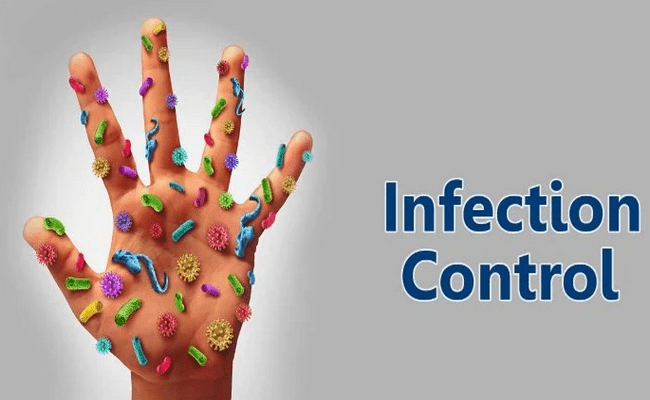Definition of Infection Control:
According to WHO, infection control may be defined as “infection prevention and control measures aim to ensure the protection of those who might be vulnerable to acquiring an infection both in the general community and while receiving care due to health problems, in a range of settings. The basic principle of infection prevention and control is hygiene.”

Infection Control in a health care facility is the prevention of the spread of microorganisms from:
- Patient to patient,
- Patient to Staff member,
- Staff member to patient.
Definition of Infection:
Infection may be defined as the invasion and multiplication of microorganisms such as bacteria, viruses, and parasites that are not normally present within the body. An infection may cause no symptoms and be subclinical, or it may cause symptoms and be clinically apparent. Entry of a harmful microbe into the body and its multiplication in the tissues / bloodstream is called infection.
General Measures or Recommendation for Infection Control in Critical Care Unit:
1. Isolation:
Assess the need for isolation. Screen all intensive care unit (ICU) patients for the following:
- Neutropenia and immunological disorder,
- Diarrhea,
- Skin rashes,
- Known communicable disease,
- Known carriers of an epidemic strain of bacterium.
2. Observe hand hygiene:
World Health Organization’s five moments for hand hygiene-
- Before touching a patient -to protect the patient from harmful germs carried on your hands.
- Before aseptic procedures – to protect the patient against harmful germs, including the patient’s own germs.
- After body fluid exposure/risk – to protect yourself and the health care environment from the harmful patient’s germs.
- After touching the patient – to protect yourself and the health care environment from the harmful patient’s germs.
- After touching the patient’s surrounding – to protect yourself and the health care environment from the harmful patient’s germs.
3. Follow standard precautions:
Standard precautions include prudent preventive measures to be used at all times, regardless of a patient’s infection status.
a) Gloves: Sterile gloves should be worn after hand hygiene procedure while touching mucous membrane and non-intact skin and performing sterile procedures (2A) e.g. arterial, central line and Foley catheter insertion.
b) Gown: Wear a gown to prevent soiling of clothing and skin during procedures that are likely to generate splashes of blood, body fluids, secretions or excretions (IB).
c) Mask, eye protection/face shield:
- Wear a mask and adequate eye protection (eyeglasses are not enough), or a face shield to protect mucous membranes of the eyes, nose and mouth during procedures and patient care activities.
- Patients, relatives and health care workers (HCWs) presenting with respiratory symptoms should also use masks (e.g. cough).
d) Shoe and head coverings: Required for visitors.
e) Patient-care equipment:
- Used patient-care equipment soiled with blood, body fluids, secretions, or excretions should be handled carefully to prevent skin and mucous membrane exposures.
- Ensure that single use items and sharps are discarded properly.
4. Follow transmission-based precautions:
a) Airborne precautions:
- Isolate with negative-pressure ventilation.
- Respiratory protection must be employed when entering the isolation room.
b) Contact precautions:
- Isolation is required,
- Non-critical patient-care equipment should preferably be of single use. If unavoidable, then clean and disinfect them adequately before using to another patient,
- Limit transport of the patient,
- Droplet precautions,
- Isolation is required,
- Respiratory protection must be employed when entering the isolation room or within 6-10 ft. of the patient. Limit transport of the patient,
- Use specific strategies focused on prevention of specific nosocomial infections.
5. Strategies to reduce VAP (ventilator-associated pneumonia):
- Avoid intubation whenever possible,
- Consider noninvasive ventilation whenever possible,
- Prefer oral intubations to nasal unless contraindicated,
- Keep head elevated at 30-45° in the semi-recumbent body position,
- Daily oral care with chlorhexidine solution of strength 0.12%.
6. Strategies to reduce CRBSI (Catheter-related bloodstream infection):
- Prefer the upper extremity for catheter insertion. Avoid femoral route for central venous cannulation (CVC).
- Use maximal sterile barrier precautions (cap, mask, sterile gown and sterile gloves) and a sterile full-body drape while inserting CVCs, peripherally inserted central catheters, or guide wire exchange (IA).
7. Strategies to reduce UTI:
- Insert catheters only for appropriate indications,
- Follow aseptic insertion of the urinary catheter,
- Maintain a closed drainage system,
- Remove the catheter when it is no longer needed.
8. Consider environmental factors:
- Cleaning and disinfection,
- Organizational and administrative measures,
- Work with hospital administration for better patient to nurse ratio in the ICU,
- Policies for controlling traffic flow to and from the unit to reduce sources of contamination from visitors, staff and equipment,
- Waste and sharp disposal policy,
- Education and training for ICU staff about prevention of nosocomial infections.

Maria Khatun Mona is a Founder and Editor of Nursing Exercise Blog. She is a Nursing and Midwifery Expert. Currently she is working as a Registered Nurse at Evercare Hospital, Dhaka, Bangladesh. She has great passion in writing different articles on Nursing and Midwifery. Mail her at “maria.mona023@gmail.com”
